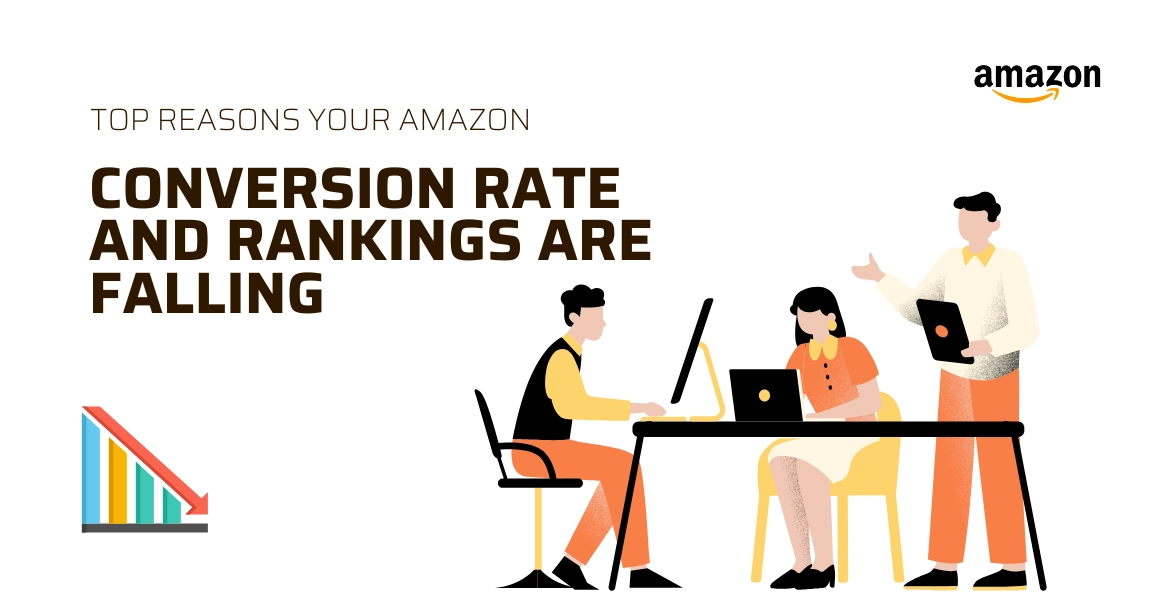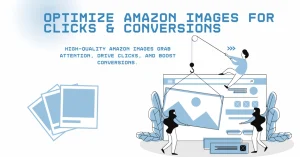Boosting Amazon Product Sales with Higher Conversion Rate
 Selling on Amazon is more than getting your products listed. Your listing is your digital storefront, and every detail in it works like a sales pitch to the shopper. A good product with poor presentation will often lose to a competitor who communicates value more clearly. Many sellers see steady traffic but very few sales, and that gap can be traced to how well the listing convinces a visitor to click the buy button. Conversion rate is likely the single most important number for any Amazon seller. It represents the number of buyers that click on your item when they view it. If the figure is not high, then something is not quite right in your listing. From poor images to ambiguous product descriptions, these are some of the culprits that can quietly drain away your sales. Understanding why your listings are not converting and how to correct them has the ability to convert lost sales to repetitive income.
Selling on Amazon is more than getting your products listed. Your listing is your digital storefront, and every detail in it works like a sales pitch to the shopper. A good product with poor presentation will often lose to a competitor who communicates value more clearly. Many sellers see steady traffic but very few sales, and that gap can be traced to how well the listing convinces a visitor to click the buy button. Conversion rate is likely the single most important number for any Amazon seller. It represents the number of buyers that click on your item when they view it. If the figure is not high, then something is not quite right in your listing. From poor images to ambiguous product descriptions, these are some of the culprits that can quietly drain away your sales. Understanding why your listings are not converting and how to correct them has the ability to convert lost sales to repetitive income.Understanding Amazon Conversion Metrics for Higher Sales
1. What Conversion Rate Means in Seller Central
In Seller Central, conversion rate is called Unit Session Percentage. It shows the percentage of visits to your listing that result in a sale. If 100 people view your listing and 12 buy your product, your conversion rate is 12 percent. This number reflects how well your listing turns interest into sales. A high rate means your listing is convincing and relevant to shoppers. A low rate means you may be attracting the wrong audience or not presenting your offer well enough.2. Benchmark Data Across Categories
Conversion rates vary based on product category. From observed data in multiple accounts:- Everyday consumer goods often see 10 to 15 percent
- Electronics can range from 5 to 10 percent
- Health and beauty products may reach 15 to 20 percent
- High-ticket or research-heavy products may be under 5 percent. Knowing your category average helps you understand if your performance is weak, average, or strong.
3. Tracking Conversion Rates in Amazon Reports- Business Reports: Go to Detail Page Sales and Traffic by ASIN to view sessions, units sold, and Unit Session Percentage.
- Brand Analytics: Use the Search Term Report to see how your product ranks for specific terms and compare click and conversion share against competitors. By
checking these reports regularly, you will help yourself spot trends, measure the effect of listing changes, and identify products that need attention.
- Business Reports: Go to Detail Page Sales and Traffic by ASIN to view sessions, units sold, and Unit Session Percentage.
- Brand Analytics: Use the Search Term Report to see how your product ranks for specific terms and compare click and conversion share against competitors. By checking these reports regularly, you will help yourself spot trends, measure the effect of listing changes, and identify products that need attention.
| Problem Area | Why It Hurts Conversion | What to Watch For |
|---|---|---|
| Poor Product Images | Shoppers rely heavily on visuals to decide quickly. Low-quality images create doubt and reduce trust. | Low-resolution photos, lack of lifestyle shots, and images that look unclear on mobile screens. |
| Weak Title and Keyword Placement | A title that does not match search intent will miss potential buyers. Keyword stuffing can make it hard to read. | Missing high search volume keywords and titles that feel unnatural. |
| Ineffective Bullet Points | Bullets that list only features do not help the shopper imagine the benefit. | Long blocks of text, technical terms without explaining value. |
| Unoptimized Product Description and A+ Content | This is where brand story and visual appeal matter most. Weak formatting reduces engagement. | Missing brand voice, no visuals, poorly structured layout. |
| Low or Negative Reviews | Social proof strongly affects purchase decisions. Low star ratings push buyers to competitors. | Few total reviews, repeated negative comments. |
| Pricing and Competitor Positioning | A price that feels too high or too low compared to similar products can reduce trust. | Not reviewing competitor pricing regularly. |
| Low Stock or Delayed Shipping | If buyers see long delivery times, they often choose a faster option. | “Ships in…” messages or low inventory warnings. |
| Irrelevant Traffic | Visitors who are not looking for your exact offer will not buy. | Poor targeting in PPC campaigns or misleading keywords. |
How to Diagnose Amazon Conversion Problems Effectively
1. Use Business Reports
- Go to “Detail Page Sales and Traffic by ASIN” in Seller Central
- Compare Sessions (visits) vs Units Ordered to find low-performing ASINs
Leverage Brand Analytics Search Term Reports
- Identify the keywords driving traffic.
- Check Click Share and Conversion Share to see if you are getting the right audience and converting them.
3. Study Competitor Listings
- Review top-selling competitors in your category.
- Compare images, titles, bullets, A+ Content, and pricing to spot positioning gaps.
Fix Low-Conversion Amazon Listings with Actionable StrategiesVisual Improvements
- Redesign the main image with a clean background and strong lighting.
- Add lifestyle shots showing the product in use.
- Ensure all images are optimized for mobile screens.
Title and Keyword Optimization
- Include primary keywords naturally.
- Make titles readable and clear without stuffing.
Bullet Point Enhancement
- Use the Feature → Advantage → Benefit method to show value.
- Keep them short, easy to scan, and focused on shopper needs.
Content Upgrades
- Add A+ Content with branded visuals and comparison charts.
- Use the Brand Story section to connect with shoppers emotionally
Review Building Strategy
- Use Amazon’s review request automation.
- Follow up with customers for genuine feedback.
Competitive Pricing Approach
- Update images and copy every few months to keep the listing fresh.
- Track category benchmarks and compare your ASIN’s performance regularly.
- Adjust for seasons by highlighting relevant use cases and keywords during peak demand periods.
Amazon Listing Conclusion & Key Takeaways for Sales
It's estimated that the vast majority of Amazon listings miss sales because of tiny, but impactful, issues that cost consumers directly, and sometimes even without them knowing it. Terrible images, terrible titles, keyword spamming, or irrelevant bullet points can sneakily push buyers to other sellers. The good news is that these mistakes are correctable if you know where to find them. Rapid wins such as product image refreshing, rebuking for benefit emphasis, and A+ Content optimization can deliver measurable conversion increases. Effective sellers tend to approach optimization as an ongoing process, as opposed to an ad hoc exercise. Frequent review of performance reports, monitoring category norms, and implementing seasonal tweaks keeps listings in a competitive and up-to-date state. For sales professionals who require assistance to improve their Amazon listing, Squatio has the capabilities, the experience, and the expertise necessary to transform lagging listings into dependable moneymakers.
Visual Improvements
- Redesign the main image with a clean background and strong lighting.
- Add lifestyle shots showing the product in use.
- Ensure all images are optimized for mobile screens.
Title and Keyword Optimization
- Include primary keywords naturally.
- Make titles readable and clear without stuffing.
Bullet Point Enhancement
- Use the Feature → Advantage → Benefit method to show value.
- Keep them short, easy to scan, and focused on shopper needs.
Content Upgrades
- Add A+ Content with branded visuals and comparison charts.
- Use the Brand Story section to connect with shoppers emotionally
Review Building Strategy
- Use Amazon’s review request automation.
- Follow up with customers for genuine feedback.
Competitive Pricing Approach
- Update images and copy every few months to keep the listing fresh.
- Track category benchmarks and compare your ASIN’s performance regularly.
- Adjust for seasons by highlighting relevant use cases and keywords during peak demand periods.



Why Is Your Amazon Conversion Rate & Rankings Dropping
Boosting Amazon Product Sales with Higher Conversion Rate Selling on Amazon is more than getting...
Share this link via
Or copy link